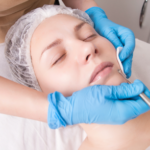
Your skin is the final frontier in your battle against bad health and appearance. If you have done everything right up until now, especially by taking care of your body and mind, it’s time to get serious about your skin. The state of your skin reflects your overall health. It can be a clear indication that something isn’t right with you. A healthy complexion tells much about our general well-being and future health prospects. Poor skin can also indicate other diseases like diabetes or liver problems. Here are some risks regarding your skin, coupled with actionable advice on how to prevent them.
1. Acne
Acne is a skin disorder that affects millions of people around the world. It is a very common disease that affects men and women alike. It may be caused by various factors, including hormonal changes, greasy foods, dirt in the pores, and other environmental factors. The most common causes of acne are excessive sebum production and clogged pores.
If you have acne, you must know that it is not something to be ashamed of or embarrassed about. If you have acne and are not using any treatment, then it’s time to do so immediately. The sooner you can find an effective treatment for your acne problem, the better off you will be in the long run.
2. Pimples and Blackheads
Pimples are caused by clogged pores (also known as blackheads), excess oil production (also known as whiteheads), and a combination of the two. Pimples can appear on your face, back, chest, neck, shoulders, or other body parts. They may appear alone or in clusters; however, they are usually found on the face and neck. These types of skin conditions usually develop when you have oily skin that’s prone to clogged pores and pimples or when you have dry skin that’s prone to excess oil production.
If you suffer from pustules (pimples containing pus), it is a sign that something is wrong with your body because pimple infections are not common in healthy people. The pus-filled pimple is often filled with bacteria, which can cause an infection if it’s not removed quickly enough by the medical staff at your local hospital. Visiting your doctor is the best option.
3. Psoriasis
Psoriasis is a skin condition caused by the immune system attacking the body’s skin cells. It can appear anywhere on the body, but it is more common on the elbows, knees, scalp, and back. The most common areas of psoriasis are red, scaly patches that may be covered with silvery scales or scales that are pale in color.
Psoriasis can cause severe itching and irritation and cause painful sores on your skin. While there is no known cure for the condition, there are various medical treatments you can try to reduce your symptoms. You only need to visit your doctor to know the best one for the infection.
4. Cellulitis
Cellulitis is a serious bacterial skin condition entering the body through a break in the skin. This can happen when you cut yourself, get an infection, or develop a wound that doesn’t heal properly.
Cellulitis typically causes red, painful sores that may ooze with pus and can cause swelling and fever. If left untreated, it can lead to sepsis and even death because it spreads quickly throughout your entire body and causes severe damage. To mitigate the issue, you need to visit your doctor.
5. Dermatitis
Dermatitis is an itchy, red rash caused by an allergic reaction. It can cause severe itching and can also develop painful sores. Dermatitis can affect any part of your body, but it is more commonly found on the scalp, face, neck, hands, and arms.
You may experience a burning sensation, swelling, redness, or tenderness in these areas. If you have dermatitis, you should see a doctor as soon as possible to help you get rid of the rash and prevent further damage to your skin. They might recommend a skin protectant barrier to prevent any more skin issues.
6. Fungal Infections
If you suffer from fungal infections, they’re more common in the feet and groin area. This is because they are warm and moist environments where fungus likes to grow easily. The most common fungal infection is athlete’s foot which causes a small red bump with a clear center on your skin between the toes or between your toes and the end of your foot. To manage this, you should apply anti-fungal creams to the affected areas and keep your feet dry.
Everyone’s favorite part of the human body—the skin—is also one of its most sensitive. From head to toe, our skin is exposed to various elements that can be damaging if not properly cared for. Fortunately, the above can help you protect your skin and avoid its associated risks.
- How To Boost Your Confidence on a First Date - February 23, 2024
- 5 Must-Try Fashion Trends for 2024 - February 14, 2024
- 12 Must-Have Items for Your Daughter’s Gift Basket - November 28, 2023






